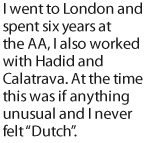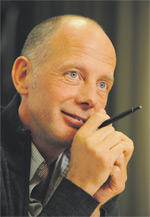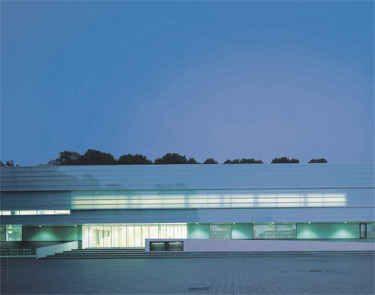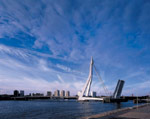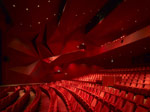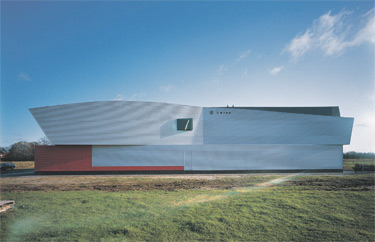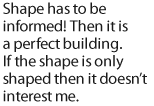
Interview

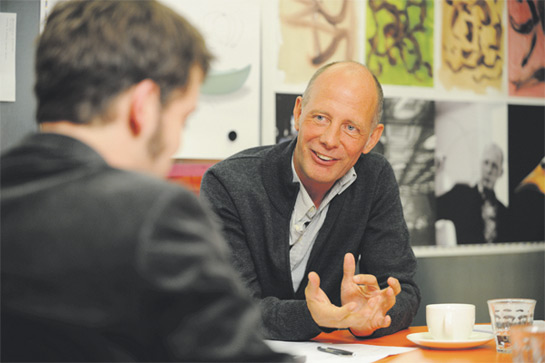
Ben van Berkel has taken a breather between two meetings, sips tea and looks both relaxed and focused behind his bright orange desk; quite clearly a question of character, as this man has a lot on his mind. He listens attentively then explains his thoughts with broad gestures, repeatedly picking up his pencil to draw small illustrative sketches on a piece of paper thrust hastily towards him – he is an architect after all. In late 2008 UNStudio celebrated its 20th anniversary but he quickly brushes aside the slightly nostalgic question as to the highlights in retrospect. “It is a great advantage that we have been able to grow gradually over the past 20 years. What we celebrated was not how great we are but the fact that we were able to spend our anniversary with people who have already been working here for 10 or 15 years. Team spirit is really important at United Network Studio, not only with Caroline Bos but with all the staff and the many external experts. The rest is Netherlands modesty. There are just as many reasons to be extremely proud of the studio’s achievements. Its 20-year history reveals not only constant growth but from the very outset an approach which is as experimental and daring as it is successful in its architectural strategy, which over the years the architects have continued to refine, adjust and elaborate.
In 2000 in his book “Superdutch”, Bart Lootsma wrote a sort of manifesto about the rapidly emerging Dutch studios at the time. UNStudio also featured in the book. Together with Rem Koolhaas, Wiel Arets, Neutelings Riedijk, West 8 and MVRDV – when did you last feel “Superdutch”?
Never. I have my problems with the word “super” - but I also have problems with the word “Dutch”. After studying in Amsterdam I went to London and spent six years at the AA, I also worked with Hadid and Calatrava. At the time this was if anything unusual and I never felt “Dutch”. Perhaps there are certain traces of Netherlands architectural history in my work. I am interested in solutions which integrate architectural and technical aspects on an equal basis - I have certain role models in this respect, for example Jan Duiker. But this would certainly not be “superdutch”. I do not wish to say anything basically negative about the book. It presents a new generation of Dutch architects.
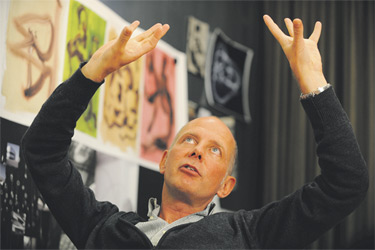
I mentioned “Superdutch” because in the book Bart Lootsma describes your earlier design drawings. Can we take these image stories to be the starting point for subsequent works on “design models” and functional diagrams with computers?
Yes, certainly. I used to draw a lot, today I have switched to painting. But this doesn’t mean I consider myself an artist although art does fascinate me enormously. Back then my drawings were simple - my painting today is much more conceptual, if anything geometric constructions. But neither sketches nor painting lead to architectural shape, an organic, non-linear process is how some of these geometric considerations find their way into projects.
You do not see yourself as an artist, but aren’t many of your products art nonetheless?
No. We only flirt with art. I like the vagueness with which we sometimes deal with architecture. Is it art? Is it not art?
You once described your first projects as a “blue period”. Why?
Yes, that’s true. I have always been fascinated with the use of color in architecture because by using color you can change the impression a building makes. At the time I was interested in the question of which color was most unlike a color and that is how I arrived at this very, very pale blue. We are speaking here about memories: When I was a child my mother used to tell me told me that she always added something blue to the white washing, so as to make the white brighter - and I thought this was crazy. Blue doesn’t make white whiter! And in school I was also the one with the pale gray t-shirts! But I discovered, of course, that she was right. When light shines brightly on this white then it really appears brighter. We used this effect on the Erasmus Bridge - in some photos it looks pale blue but in daylight photos it radiates white.
Incidentally you see similar effects in the glass facades of the Het Valkhof Museum which changes between green and blue and we also used a similar effect in the NMR laboratory building in Utrecht.
When the Mercedes-Benz building was completed in 2006 there was a large exhibition of your work in Deutsches Architekturmuseum. Your projects were categorized there in terms of five different “design models”. How many models do you use these days?
We work with several models. We are continuously developing our models. However, it is not about how many models you use, but how you use them. What is most important is not to take the route the Modernists took. They saw the grid as a holy universal system. Modern architects have already worked a lot with diagrams but they only do so to achieve a reduction - you take a model and then build the model. This is not something we are interested in - we want these models to completely unfold in our works. Unfolding instead of reduction. Instead of finding a single, ideal, universally usable model I want to keep it operative and experimental, it should constantly continue to develop. Every pattern produces one thing above all: a lot of dead ends. And that’s where the idea came from to combine these ends with one another, and lo and behold, the Möbius strip! Even today I am excited by this idea of infinite space.
Would you generally refer to your working style as “experimental”?
Of course. In dealing with design models certain series have emerged in our work, but at the latest after five projects we reach a point when we realize that we have to change the concept. The same goes with color. We had this “blue period” now we are using very strong colors - like in the Agora Theater in Lelystad and the Galleria Store in Seoul. Our architectural language changes. Strangely enough a lot of people criticize this. There are many architects whose work you instantly recognize because they apply very consistent, repetitive working methods. But this is not what I want. I want my work to have differences - the more the better. I am almost proud when people criticize us for this. So we are still experimenting. Not every time of course - as an architect you are responsible for the budget, and experiments require very precise research. We continue to gain a better understanding of when we can experiment and when not. If the client is really interested in originality and understands what is required then we are very happy to try out things which have never been tried before.
But in your work there are also certain series and consistently developed ideas...
Yes. There are recurring themes in our projects. But these ideas advance and produce new ideas. I like the idea that by their conceptual idea you can recognize our buildings as part of a series. Our “Blob-Box Model” for example can be found in Het Valkhof Museum, in the station at Arnhem in VilLA NM and in the Music Theater in Graz. But it is difficult to recognize because precisely this model deliberately defies stylistic debate! We do not seek to avoid the use of patterns for any dogmatic reasons. Patterns are very helpful when it comes to offices and residential buildings - but infrastructure such as trains and interstates are difficult to put into structured boxes. They need ramps and spirals. This argumentation leads to linking the two models depending on the functional demands of the building. As such almost all our projects are infrastructures - the Mercedes-Benz Museum as well, with its access in the shape of a dual 3D helix around a large open space is primarily a major infrastructure. We developed its inner structure from the clover leaf shape of interstate interchanges. Basically if you look at the site plan it looks like a slightly off-center interstate intersection.What is important to us are the transformation aspects of this combination of Blob and Box, and how we can design the interfaces. And perhaps herein lies the secret of our architecture. We use the grid, we use the Box and the Blob. This doesn’t bother us. Lots of people believe that the Blob and Box stand irreconcilably at opposite ends of the scale and the architect can only decide on one or the other. I really would like to liberate architecture from this stylistic discussion.
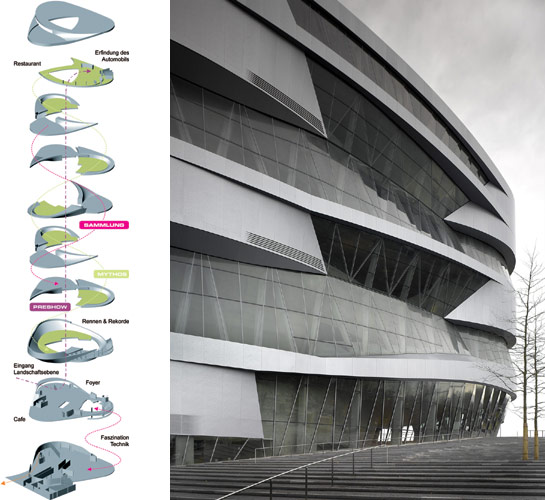
You mentioned Jan Duiker before and his influence on your architecture - do you also have something in common with Modernism?
Yes, of course. I was speaking about the contradiction between function and aesthetics and how we are trying to expand this model. I would say that the Mercedes-Benz Museum radiates a certain calmness similar, perhaps, to buildings by Mies van der Rohe. How do we achieve this? By repeating and organizing a relatively small number of geometric elements in the space. I have never explained this well enough before but we are still working with concepts and repetition and serial production. The KARBOUW building consists of a number of asymmetrical curves but we composed these curves out of just three different elements. In the Möbius house we only used three different angles. Modernism believes that you can only achieve harmony with rectangular rooms - but our layout of serial elements enables us to create very complex spaces which can nevertheless radiate the calmness of a rectangular space.
Would you agree that UNStudio is more interested in the perfect inner organization of a building than its shape?
Definitely. I have never been particularly inspired by a building’s shape. I believe in a building’s organization and how this organization can permeate the overall design.
Is the shape irrelevant then?
Well - to a certain extent, yes. Shape has to be informed! Then it is a perfect building. If the shape is only shaped then it doesn’t interest me.
Would that then be the main concern in all your projects: finding the informed shape?
Yes, but there is more to it than that. Buildings also have to communicate: If the building produces no afterimage then it is not good architecture. To me afterimage refers to what remains in your mind after you read a good book or see a fascinating painting or a beautiful film. You remember it, it creates memories - an image which remains in your mind. A good building must also be able to do this, it should leave people with an afterimage. Actually this was how I first became interested in architecture - I saw buildings and thought “Wow! Amazing!” And I want my buildings to leave a similar impression.
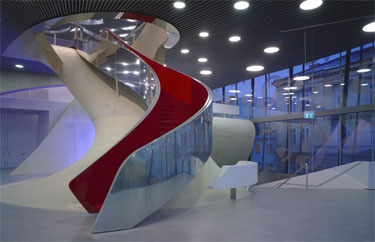
Florian Heilmeyer conducted the conversation.
Florian Heilmeyer lives and works on the road, as of 1978 primarily in Berlin. He organizes exhibitions and writes - in order to present architecture to a wider audience: to this end he is active as a publicist, curator and editor. He contributes regularly to Deutsches Architektenblatt,
MARK – Another Architecture, Werk Bauen + Wohnen among others, and it one of the Baunetz editors. Most recently, he helped curate the exhibitions „Updating Germany“
(2008), „Shrinking Cities“ (2007-8), „Unaufgeraeumt – As Found“ (2007), „Talking Cities“ (2006) and „Bewegtes Land“ (2005).
project management: Andrea Nakath












































